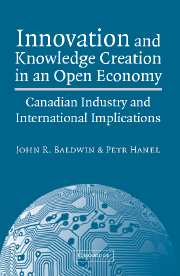 Innovation and Knowledge Creation in an Open Economy
Innovation and Knowledge Creation in an Open Economy Book contents
- Frontmatter
- Contents
- List of Tables and Figures
- Acknowledgments
- 1 The Economics of Knowledge Creation
- 2 The Innovation Survey
- 3 Patterns of Innovation: Intensity and Types
- 4 Sources of Innovations
- 5 Research and Development and Innovation
- 6 Effects of Innovation
- 7 Innovation and Research and Development in Small and Large Firms
- 8 Innovation Regimes and Type of Innovation
- 9 The Use of Intellectual Property Rights
- 10 Multinationals and the Canadian Innovation Process
- 11 Financing and the Cost of Innovation
- 12 The Diffusion of Innovation
- 13 Strategic Capabilities in Innovative Businesses
- 14 Determinants of Innovation
- 15 Summary
- Appendix The Innovation and Advanced Technology Survey
- References
- Index
2 - The Innovation Survey
Published online by Cambridge University Press: 28 August 2009
- Frontmatter
- Contents
- List of Tables and Figures
- Acknowledgments
- 1 The Economics of Knowledge Creation
- 2 The Innovation Survey
- 3 Patterns of Innovation: Intensity and Types
- 4 Sources of Innovations
- 5 Research and Development and Innovation
- 6 Effects of Innovation
- 7 Innovation and Research and Development in Small and Large Firms
- 8 Innovation Regimes and Type of Innovation
- 9 The Use of Intellectual Property Rights
- 10 Multinationals and the Canadian Innovation Process
- 11 Financing and the Cost of Innovation
- 12 The Diffusion of Innovation
- 13 Strategic Capabilities in Innovative Businesses
- 14 Determinants of Innovation
- 15 Summary
- Appendix The Innovation and Advanced Technology Survey
- References
- Index
Summary
INTRODUCTION
As productivity growth in Western countries slowed in the post-1973 period, economists and statisticians increasingly turned to understanding the growth process. This interest has led to studies of innovation.
Unfortunately, data on innovation have been difficult to assemble. Data on patents have supported a set of studies. But many innovations are not patented and, therefore, patent data was seen as providing only partial coverage of the innovation process. Data on research and development also existed and could be used to examine differences in the tendencies of small and large firms to innovate; but R&D is only one of the inputs into innovation, and exclusive reliance on R&D data can, therefore, be misleading. Finally, case studies of particular innovations can shed light on the evolutionary process that takes place across the product life cycle. But it is difficult to know how to draw generalizations from case studies that may not be very representative of all firms.
Innovation surveys have evolved in an attempt to provide more detailed data on the process that is behind economic growth. Innovation surveys extend data collection beyond R&D inputs to an examination of some of the other essential ingredients — such as the importance of technology transfer. But their chief claim to originality is the measurement of innovative output.
DEFINING INNOVATION
Measuring innovative output is difficult. Innovations can be described in many different dimensions.
Information
- Type
- Chapter
- Information
- Innovation and Knowledge Creation in an Open EconomyCanadian Industry and International Implications, pp. 29 - 42Publisher: Cambridge University PressPrint publication year: 2003